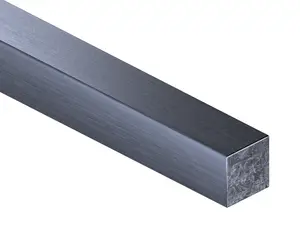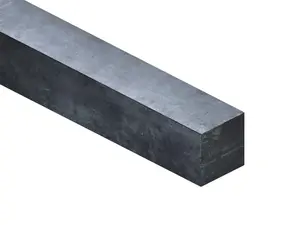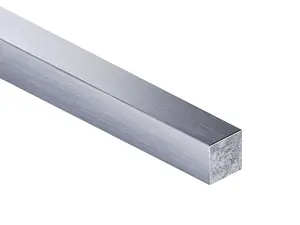An indispensable component of many steel structures, square steel bars offer the perfect combination of strength and functionality. These versatile elements can be found in a wide range of applications - from building structures to precision machinery components. We offer two main types of square bars: drawn and hot-rolled.
Characteristics of square bars
Square bars are characterized by a square cross-section, and their construction allows them to provide stability and strength in many structures.
Drawnsquare bars are produced by drawing pre-prepared material, which gradually reduces its cross-section to the desired dimension. The drawing process provides the bars with a smooth square surface and a precise cross section. Moreover, the smooth square bar obtained in this way shows increased strength and structural uniformity compared to other production methods. Square steel bars obtained by this method are ideal where precision and material uniformity are required.
Hot-rolled square bars, on the other hand, are produced by hot-rolling steel bars in special rolling mills. This process involves heating the steel to very high temperatures, after which it is passed through a rolling mill, which gives it the desired shape. Hot-rolled solid square bars usually have a rough surface and lower dimensional accuracy compared to drawn bars. Nevertheless, they are more suitable for applications where load absorption capacity and resistance to mechanical damage play a key role.
Features and advantages of square bars
Features of drawn and hot-rolled square bars:
- Square bar has a uniform, square cross-section.
- Drawn square bars are characterized by a smooth surface.
- Smooth square bar produced by drawing technique shows higher dimensional precision.
- Hot-rolled square bars have a rough surface.
Advantages of drawn and hot-rolled square bars:
- Square bars for construction are highly durable and resistant to various types of loads.
- Drawn bars provide greater structural uniformity, which translates into better mechanical properties.
- Solid square bars made by hot-rolling are ideal for applications where load absorption capacity and impact resistance are key.
- Both types of bars allow for wide adaptability in various industries, making them a versatile solution for many structural applications.
Steel grades
We offer square bars in C45 (1.0503), C45E (1.1191), C45E+C (1.1191), S235JR (1.0038) and S235JRC+C (1.0122) steels.
C45 (1.0503)
- Features: medium-carbon steel of moderate strength. It has good weldability and heat treatment properties.
- Advantages: good mechanical properties, can be hardened, which increases its hardness.
- Disadvantages: requires appropriate heat treatment to achieve optimum properties.
C45E (1.1191)
- Features: medium-carbon steel with alloying elements. It has better weldability compared to C45.
- Advantages: high strength, good weldability and heat treatment. Ideal for producing square steel bars.
- Disadvantages: higher price compared to basic steel grades.
C45E+C (1.1191)
- Features: similar to C45E, but subjected to an additional process to improve mechanical properties, such as by drawing.
- Advantages: higher strength and uniformity compared to C45E. Excellent for producing solid square bars. -
- Disadvantages: requires more precise processing and is more expensive.
S235JR (1.0038)
- Features: structural steel with low carbon content. It is characterized by good welding properties.
- Advantages: optimal combination of strength and ductility. Ideal for producing square bars for construction.
- Disadvantages: not designed for hardening processes, which limits its hardness range.
S235JRC+C (1.0122)
- Features: version of S235JR subjected to an additional process to improve its mechanical properties.
- Advantages: high homogeneity, better strength and hardness compared to S235JR.
- Disadvantages: higher price and more complicated production process compared to S235JR.
Each of these steels has specific properties that make them suitable for various industrial applications.
Applications for square bars
Square bars are an important component in many industrial sectors due to their strength and versatility. They are used both in various structures and as decorative elements.
In general, square bars for structures are used in construction, engineering and automotive industries. Their main advantage is their ability to take up and distribute loads, which makes them an important component of many steel structures.
As for drawn square bars, their precision manufacturing process, which ensures their uniformity and smooth surface, makes them ideal for applications requiring dimensional accuracy. The high surface quality makes them ideal for the tooling industry, the manufacture of precision machine components, and where aesthetics are required in conjunction with function, such as in finishing components.
Hot-rolled square bars, on the other hand, are characterized by exceptional strength, making them excellent for applications where load absorption capacity and impact resistance are key. They are components often used in the construction industry, especially in load-bearing structures, as well as in heavy industry, in the manufacture of machinery and equipment.
Tips for investors
- Define the application - before buying square bars, think carefully about what application you will need them for.
- Choose the technology - consider whether drawn bars, which offer dimensional precision, or hot-rolled bars, which provide greater strength, will be more suitable in your case.
- Quality testing - make sure the supplier can provide quality certificates and test results confirming the properties of square steel bars.
- Material availability - make sure the supplier has the right amount of product in stock or what the lead time is.
- Technical consultation - get technical advice from the supplier - a good vendor will be able to help you select the right square bar for your needs.
- Shipping costs - depending on the quantity and dimensions of the square bars you order, shipping costs can significantly affect the final price of the product. Consider different delivery options.
Storage of square bars
Proper storage of square bars is key to maintaining their quality and functionality. Our recommendations:
- Choosing the right storage location - to ensure optimal conditions for square bars, choose a place that is dry, well-ventilated and protected from direct weathering.
- Substrate - store square steel bars on a level, stable and clean surface, preferably on special racks or pallets that provide adequate air circulation.
- Horizontal arrangement - square bars should be stored horizontally to avoid bending or deformation due to their own weight.
- Corrosion protection - in areas of high humidity, consider using anti-corrosive agents or special protective packaging.
- Accessibility - make sure square bars are easily accessible, while maintaining sufficient distance between stacks to ensure safety during handling.
- Inspections - regularly inspect the warehouse, checking the condition of square bars for corrosion, deformation or other damage.
Did you know
- Unlike traditional round bars, square bars provide a greater moment of inertia for rotation about an axis, making them more resistant to torsion.
- Square bars can be formed from a variety of steels, including stainless, carbon or alloy, giving engineers a wide range of options for material properties.
- In addition to typical engineering applications, square bars are often used in artistic and architectural projects due to their aesthetic appearance and formability.
- Due to their geometry, square bars have excellent compressive strength, making them an ideal material for certain structural applications where compressive stresses predominate.
Square bars - why from us?
Moris Steel Wholesale offers a very wide selection of top quality square bars for demanding customers. Our professional service focuses on technical advice and customization of the offer to meet the individual needs of the company. With flexible delivery methods, we provide fast and hassle-free access to our products at any location.
FAQ
How much does square bar 12 weigh?
The weight of a square bar depends on its length and the density of the material from which it is made. Steel bars have a density of about 7.85 g/cm³.
For example, to calculate the mass of a steel bar with a cross section of 12 x 12 mm (1.2 x 1.2 cm) and a length of 1 meter, you can use the following formula:
mass = density x volume
The volume of the bar is length x width x height, which in this case is 1 m x 1.2 cm x 1.2 cm = 1.44 cm³ (considering that 1 m = 100 cm).
Therefore, the mass of the rod is about 7.85 g/cm³ x 1.44 cm³ = 11.3 g for every centimeter of rod. For a rod with a length of 1 meter, the mass is about 1.13 kg.
Remember, however, that this value is only an approximation and the actual weight of the bar may vary slightly depending on the specifics of production and the precision of cutting. Therefore, it is always a good idea to check the product specifications with the supplier.



